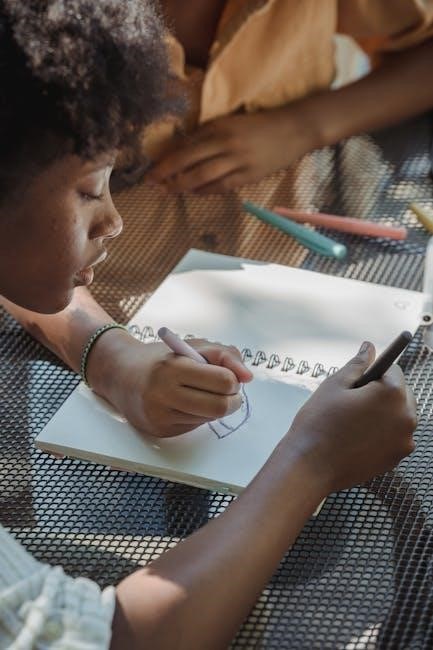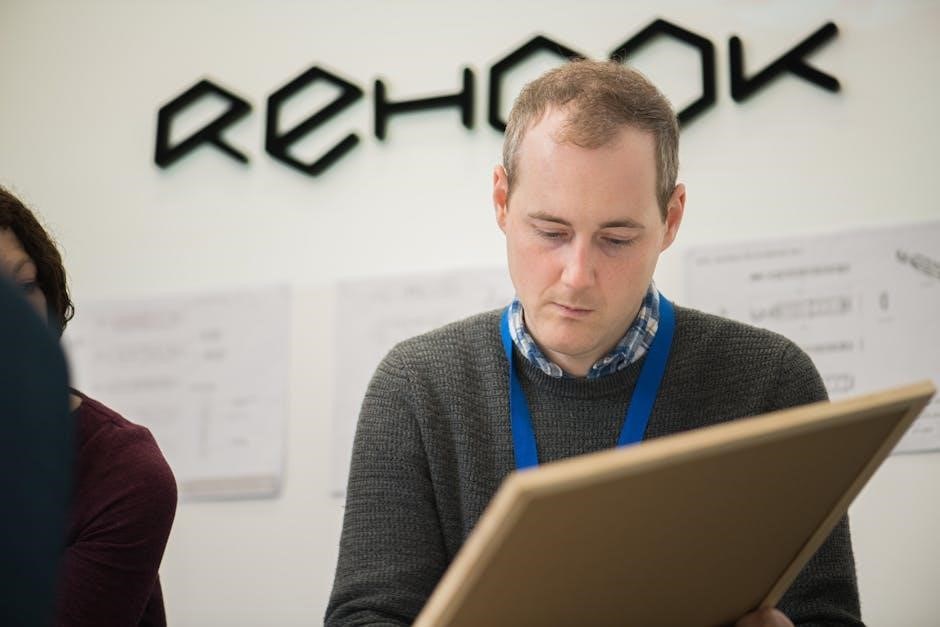A personal project is an initiative taken beyond academics‚ showcasing passion‚ creativity‚ and problem-solving skills. It demonstrates initiative‚ commitment‚ and the ability to apply learning practically‚ making it a powerful tool for personal growth and standing out in college admissions.
1.1 What is a Personal Project?
A personal project is a self-directed initiative that allows individuals to explore their passions‚ interests‚ and skills. It is an opportunity to create meaningful outcomes‚ solve real-world problems‚ or address community needs. Personal projects are often beyond academic requirements‚ demonstrating initiative‚ creativity‚ and commitment. They can take many forms‚ such as building a product‚ launching a community program‚ or creating art. These projects are personal because they reflect the individual’s interests and goals‚ showcasing their ability to apply learning in practical ways. Colleges and organizations value personal projects as they highlight problem-solving skills‚ critical thinking‚ and the ability to take initiative.
1.2 Why Personal Projects are Important
Personal projects are powerful tools for showcasing skills‚ initiative‚ and passion. They demonstrate an individual’s ability to apply knowledge in real-world contexts‚ making them highly valued by colleges and employers. These projects highlight creativity‚ problem-solving‚ and commitment‚ setting applicants apart in competitive processes. By pursuing personal interests‚ individuals develop a deeper understanding of their strengths and interests‚ fostering personal growth. Personal projects also reflect dedication‚ resilience‚ and the ability to take initiative‚ traits that admissions officers and hiring managers seek. They provide tangible evidence of an individual’s ability to transform ideas into meaningful outcomes‚ making them a compelling part of any application or portfolio.
1.3 Benefits of Personal Projects in College Admissions
Personal projects significantly enhance college applications by showcasing initiative‚ creativity‚ and problem-solving skills. They demonstrate an applicant’s ability to apply knowledge in real-world contexts‚ highlighting passion and commitment. Colleges value projects that reveal a student’s unique voice and dedication to meaningful causes. By sharing personal projects‚ applicants stand out in a competitive pool‚ illustrating their ability to think critically and innovate. These projects also reflect resilience‚ as they often involve overcoming challenges‚ which is highly regarded by admissions officers. A well-executed personal project adds depth to an application‚ proving a student’s readiness to contribute creatively and effectively in college and beyond.

Choosing the Right Topic for Your Personal Project
Selecting the right topic involves aligning your passions with feasible goals‚ ensuring the project is meaningful and reflects your interests‚ while also demonstrating creativity and initiative.
2.1 Identifying Your Passions and Interests
Identifying your passions and interests is the foundation of a successful personal project. Start by reflecting on what excites you‚ whether it’s environmental sustainability‚ technology‚ art‚ or community service. Consider your hobbies‚ academic strengths‚ and extracurricular activities to find overlaps. For example‚ if you’re passionate about technology and helping others‚ creating a tech tutoring program for seniors could be an ideal project. Aligning your project with your genuine interests ensures motivation and enjoyment‚ making the process fulfilling rather than a chore. This step helps you uncover what truly drives you‚ setting the stage for a meaningful and impactful project.
2.2 Aligning Your Project with Your Skills and Goals
Aligning your personal project with your skills and goals ensures it is both feasible and meaningful. Start by assessing your current skills‚ such as coding‚ writing‚ or leadership‚ and identify areas where you’d like to grow. Set SMART (Specific‚ Measurable‚ Achievable‚ Relevant‚ Time-bound) goals that align with your aspirations‚ whether academic or career-oriented. For instance‚ if you aim to study environmental science‚ a project focused on sustainability will showcase relevant skills and dedication. This alignment not only enhances the project’s impact but also demonstrates your ability to connect personal interests with broader objectives. Seek mentorship or resources to bridge skill gaps‚ ensuring your project reflects your strengths while challenging you to grow.
2.3 Brainstorming Ideas for Your Project
Brainstorming ideas for your personal project begins with identifying your passions and interests. Start by creating a mind map‚ listing hobbies‚ academic strengths‚ and extracurricular activities. Ask yourself‚ “What problem can I solve?” or “What topic excites me?” Consider combining interests‚ like environmental science and technology‚ to create a unique project. For example‚ developing an app to track carbon footprints or starting a podcast on local history. Reflect on real-world issues‚ such as mental health or sustainability‚ to inspire impactful ideas. Prioritize projects that align with your skills and goals‚ ensuring they are both challenging and achievable. This creative process helps you refine ideas and choose a meaningful direction.

Setting a Goal for Your Personal Project
Setting a clear and specific goal is crucial for guiding your personal project. It provides direction‚ helps measure progress‚ and ensures your efforts remain focused and purposeful‚ leading to a meaningful outcome.
3.1 Defining a Clear and Specific Objective
Defining a clear and specific objective is essential for a successful personal project. It involves identifying a precise problem to solve or goal to achieve‚ ensuring your efforts remain focused. A well-defined objective helps break down the project into manageable steps and provides a roadmap for success. It also allows you to measure progress and stay motivated. By aligning your objective with your passions and skills‚ you create a meaningful and impactful project that showcases your abilities and dedication. A clear objective sets the foundation for a project that is both achievable and inspiring.
3.2 Creating a Vision for Your Project
Creating a vision for your project involves imagining its ultimate impact and outcome. This step helps you define the purpose and significance of your work‚ ensuring it aligns with your passions and goals. A clear vision motivates you to stay committed and guides decision-making throughout the process. It also helps communicate the value of your project to others‚ whether it’s for college applications or personal fulfillment. By envisioning the final result and its potential to make a difference‚ you set a powerful foundation for bringing your ideas to life and creating something meaningful.
3.3 Breaking Down Your Goal into Manageable Steps
Breaking down your goal into manageable steps is essential for maintaining momentum and ensuring progress. Start by identifying the main objectives and then divide them into smaller‚ actionable tasks. Prioritize these tasks based on importance and urgency‚ creating a logical sequence. Develop a timeline to track your progress and remain accountable. Regularly review and adjust your plan to accommodate challenges or new insights. This structured approach helps simplify the process‚ making your project less overwhelming and more achievable. By focusing on one step at a time‚ you can steadily move toward your vision and ultimately realize your goal.

Planning Your Personal Project
Planning involves creating a detailed project plan‚ setting realistic timelines‚ and allocating resources. This structured approach ensures clarity‚ organization‚ and successful execution of your personal project goals.
4.1 Developing a Project Plan
Developing a project plan is crucial for organizing your personal project effectively. Start by defining clear objectives and breaking them into smaller‚ manageable tasks. Use a step-by-step approach to outline timelines‚ resources‚ and deliverables. Identify potential challenges and create contingency plans to address them. A well-structured plan ensures accountability and helps maintain focus throughout the project. Regularly review and adjust your plan to adapt to changes and progress. Tools like Gantt charts or to-do lists can help visualize tasks and deadlines‚ making your project more manageable and increasing the likelihood of successful completion. Consistency and adaptability are key to staying on track.
4.2 Setting a Realistic Timeline
Setting a realistic timeline is essential for managing your personal project effectively. Start by breaking down the project into smaller tasks and estimating the time required for each. Create a detailed schedule with specific deadlines and milestones to track progress. Consider your availability and commitments‚ ensuring the timeline is flexible yet achievable. Regularly review and adjust the timeline to account for unexpected challenges or changes. Use tools like calendars or project management apps to stay organized and on track. A well-planned timeline helps maintain focus and ensures steady progress toward your project goals. Consistency and adaptability are key to meeting deadlines successfully.
4.3 Allocating Resources and Budget
Allocating resources and budget is crucial for the successful execution of your personal project. Identify the materials‚ tools‚ and funds required to bring your project to life. Create a detailed budget to avoid overspending and ensure transparency in resource allocation. Consider cost-effective alternatives and seek free or low-cost resources when possible. For example‚ utilize open-source software or repurpose materials to minimize expenses. Organize your resources efficiently‚ using project management tools to track usage and stay within budget. Flexibility is key‚ as unexpected costs may arise. Regularly review and adjust your budget to align with project needs‚ ensuring financial sustainability throughout the process. Proper resource management enhances productivity and overall success.

Conducting Research for Your Project
Conducting research involves identifying reliable sources‚ evaluating information‚ and documenting the process to ensure a well-informed project foundation.
5.1 Identifying Reliable Sources of Information
Identifying reliable sources is crucial for a well-informed personal project. Start by evaluating the credibility of authors and publications. Academic journals‚ government websites‚ and established organizations are trustworthy. Avoid unverified blogs or biased content. Use library databases or reputable search engines to find peer-reviewed articles. Verify information by cross-checking multiple sources. For technical projects‚ explore official documentation or expert forums. Always document your sources to maintain transparency and accountability. This step ensures your research is accurate‚ relevant‚ and adds value to your project‚ making it more credible and impactful.
5.2 Evaluating and Organizing Your Research
Evaluating and organizing your research is essential for a coherent and focused personal project. Start by assessing the relevance and credibility of each source‚ ensuring it aligns with your project’s goals. Categorize information into themes or subtopics to create a logical structure. Use tools like mind maps or spreadsheets to visualize and organize data. Highlight key insights and note areas requiring further exploration. This process helps refine your project’s focus and ensures a smooth workflow. Proper organization also makes it easier to reference materials later‚ saving time and reducing stress during the development phase.
5.3 Documenting Your Research Process
Documenting your research process is crucial for tracking progress and reflecting on your journey. Keep a detailed record of sources‚ findings‚ and insights using a journal or digital tool. Note how each discovery influences your project’s direction. Regular updates help maintain organization and provide a clear timeline of your work. This documentation not only aids in creating a comprehensive final report but also serves as evidence of your commitment and problem-solving skills. By systematically recording your process‚ you can easily revisit key steps and share your methodology with others‚ showcasing your thoroughness and dedication to your personal project.

Developing the Product or Outcome
Transform your ideas into a tangible product by creating a prototype‚ refining it through feedback‚ and iterating until you achieve a polished‚ impactful outcome.
6.1 Creating a Prototype or Initial Version
Starting with a prototype or initial version is crucial for bringing your project to life. This step involves translating your ideas into a tangible form‚ whether it’s a digital product‚ a physical creation‚ or a service. Begin by outlining the core features or elements that define your project. Use sketches‚ wireframes‚ or mockups to visualize the concept. For tech projects‚ coding a basic version or setting up the foundational structure is essential. For non-tech projects‚ gathering materials and creating a preliminary design sets the stage. Remember‚ the prototype doesn’t need to be perfect—it’s a starting point for refinement and iteration.
6.2 Refining Your Project Based on Feedback
Refining your project based on feedback is a critical step in ensuring its success. Start by seeking input from mentors‚ peers‚ or experts to identify areas for improvement. Analyze the feedback objectively‚ prioritizing constructive suggestions that align with your project’s goals. For example‚ if you’re building an app‚ test it with users and incorporate their insights to enhance functionality and user experience. Similarly‚ for creative projects‚ use feedback to refine aesthetics or messaging. Document the changes you make and reflect on how they strengthen your project. Iteration is key—embrace feedback as a tool to evolve your project from good to exceptional.
6.3 Finalizing the Product or Outcome
Finalizing your project involves completing its development‚ ensuring it meets your goals‚ and preparing it for presentation. Conduct a thorough review to address any remaining issues and polish the final product. Test the outcome rigorously‚ whether it’s a prototype‚ app‚ or creative work‚ to ensure functionality and quality. Document your process‚ including challenges and solutions‚ to provide context. Organize your findings‚ reflections‚ and results cohesively‚ highlighting the project’s significance. Showcase your work professionally‚ as this is often the first impression for colleges or audiences. Celebrate your achievement‚ knowing the effort reflects your dedication and growth.

Overcoming Challenges and Setbacks
Overcoming challenges involves identifying obstacles‚ leveraging creativity‚ and embracing setbacks as growth opportunities. Develop problem-solving skills‚ stay resilient‚ and turn failures into valuable learning experiences.
7.1 Identifying Potential Obstacles
Identifying potential obstacles early in your personal project is crucial for success. Common challenges include time management‚ skill gaps‚ and unclear goals. Reflect on past experiences to anticipate issues like procrastination or resource limitations. Proactively assess risks such as technical difficulties or lack of motivation. Consider external factors like conflicting commitments or unexpected setbacks. Consulting mentors or peers can provide insights into potential pitfalls. Conducting a SWOT analysis (Strengths‚ Weaknesses‚ Opportunities‚ Threats) helps pinpoint vulnerabilities. By acknowledging these challenges‚ you can develop strategies to mitigate them‚ ensuring your project stays on track. Early identification allows for contingency planning‚ fostering resilience and adaptability;
7.2 Developing Problem-Solving Skills
Developing problem-solving skills is essential for navigating the challenges of personal projects. As you encounter obstacles‚ breaking them down into manageable parts helps maintain progress. Seeking advice from experts and learning from setbacks fosters resilience. Embracing failure as a learning opportunity allows for creative solutions and adaptability. By documenting your problem-solving process‚ you can reflect on strategies and refine your approach. This iterative method enhances critical thinking and resourcefulness. Over time‚ these skills become invaluable‚ not just for your project‚ but for future endeavors as well.
7.3 Embracing Failure as Part of the Learning Process
Embracing failure is a crucial part of the personal project journey. It’s natural to encounter setbacks‚ but these moments are opportunities for growth. Instead of viewing failure as discouraging‚ recognize it as a stepping stone to improvement. By iterating and refining your approach‚ you can turn failures into valuable lessons. For example‚ if your initial prototype doesn’t work‚ use the feedback to adjust your strategy. Documenting these experiences helps you reflect on what went wrong and how to adapt. This mindset fosters resilience and resourcefulness‚ essential skills for both your project and future endeavors.

Showcasing Your Personal Project
Showcasing your personal project involves presenting your work effectively to highlight its impact and significance. Whether through a presentation‚ portfolio‚ or sharing outcomes‚ it communicates your achievements clearly.
8.1 Preparing a Presentation or Portfolio
Preparing a presentation or portfolio for your personal project is crucial for showcasing your efforts effectively. Start by summarizing your project’s objective‚ process‚ and outcomes in a clear and concise manner. Use visual aids like images‚ charts‚ or videos to make your presentation engaging. Highlight key achievements‚ challenges overcome‚ and lessons learned. For a portfolio‚ organize your work chronologically‚ displaying progress from inception to completion. Ensure your materials are professional and reflect your passion. Tailoring your presentation to your audience‚ whether for college admissions or a community event‚ will help emphasize its relevance and impact. Practice your delivery to convey confidence and enthusiasm.
8.2 Writing About Your Project for College Applications
Writing about your personal project in college applications requires a compelling narrative that highlights your motivation‚ process‚ and impact. Begin by explaining why you chose the project‚ connecting it to your passions and goals. Describe the challenges you faced and how you overcame them‚ showcasing resilience and creativity. Quantify your achievements and the difference your project made‚ whether in your community or personally. Reflect on the skills and insights gained‚ demonstrating how they align with your future aspirations. Use specific examples to illustrate your growth and initiative. Tailor your narrative to each college‚ emphasizing how your project reflects the values and opportunities they offer. This will help admissions officers see your potential and unique contributions.

8.3 Sharing Your Project with Others
Sharing your personal project with others amplifies its impact and allows you to gain feedback‚ recognition‚ and inspiration. Present your work through presentations‚ portfolios‚ or online platforms to showcase your achievements. Engage with your audience by explaining your motivation‚ process‚ and outcomes. Sharing your project can inspire others‚ demonstrate your initiative‚ and highlight your ability to communicate complex ideas. Whether through social media‚ community events‚ or school exhibitions‚ sharing your project fosters connections and pride in your accomplishments. It also provides an opportunity to refine your project based on others’ insights‚ turning it into a meaningful and impactful experience for both you and your audience.

Examples of Successful Personal Projects
Successful personal projects often highlight creativity and initiative‚ such as community gardens‚ tech tutoring for seniors‚ recycled art exhibits‚ mental health awareness blogs‚ and local history podcasts‚ showcasing skills and creativity.
9.1 Community Garden Initiative
A community garden initiative is a personal project where students transform unused spaces into sustainable gardens‚ promoting environmental awareness and providing fresh produce to locals. This project‚ fueled by a passion for sustainability‚ involves planning‚ coordinating with community members‚ and educating others on eco-friendly practices. By addressing a real-world issue‚ it demonstrates leadership‚ teamwork‚ and commitment to social and environmental change‚ making it a compelling addition to college applications.
9.2 Tech Tutoring for Seniors
Tech Tutoring for Seniors is a personal project where students teach older adults how to use technology‚ such as smartphones‚ computers‚ and the internet. This initiative bridges the digital divide and fosters intergenerational connections. By creating a structured curriculum and conducting one-on-one sessions‚ students demonstrate patience‚ leadership‚ and communication skills. The project highlights a commitment to community service and the practical application of technical knowledge. It also showcases the ability to break down complex concepts into understandable lessons‚ making it a standout activity for college applications while empowering seniors to navigate the digital world confidently.
9.3 Recycled Art Exhibit
The Recycled Art Exhibit is a creative personal project that transforms discarded materials into meaningful art pieces‚ raising awareness about environmental sustainability. Students collect various recyclables‚ design unique sculptures or installations‚ and showcase their work in a public space or online gallery. This project combines artistic expression with environmental advocacy‚ demonstrating resourcefulness and innovation. By organizing the exhibit‚ students also develop event-planning and community-engagement skills. The project highlights their ability to think critically about waste and inspire others to adopt eco-friendly practices‚ making it a compelling addition to college applications while fostering a positive impact on the community and the environment.
9.4 Mental Health Awareness Blog
A Mental Health Awareness Blog is a personal project that focuses on creating a platform to share resources‚ personal stories‚ and tips to promote mental well-being. Students can design the blog to address topics like stress management‚ mindfulness‚ and self-care‚ targeting adolescents or their community. By conducting research and interviewing experts‚ they compile credible information to help others. The blog showcases their ability to communicate complex ideas clearly and empathetically. It also highlights their commitment to fostering positive change‚ demonstrating initiative and compassion. This project not only benefits readers but also reflects the student’s dedication to understanding and improving mental health‚ making it a meaningful and impactful endeavor.
9.5 Local History Podcast
A Local History Podcast is a personal project where students explore and share stories about their community’s past. By interviewing residents and researching archives‚ they create engaging episodes that highlight historical events and cultural traditions. This project allows students to connect with their heritage while developing strong communication and storytelling skills. It also fosters a sense of community by preserving local memories and making history accessible to a wider audience. The podcast demonstrates creativity‚ research abilities‚ and a passion for history‚ making it a standout activity in college applications and a valuable resource for future generations.
A personal project is a transformative journey that fosters growth‚ showcases passion‚ and highlights your unique strengths. It leaves a lasting impact‚ both personally and academically.
10.1 The Power of Personal Projects
A personal project is a transformative experience that empowers individuals to showcase their passions‚ creativity‚ and problem-solving abilities. It demonstrates initiative‚ commitment‚ and the ability to apply learning in real-world contexts‚ making it a powerful tool for personal growth and standing out in college admissions.
By undertaking a personal project‚ students highlight their unique strengths‚ resilience‚ and adaptability. Colleges value such initiatives as they reveal a student’s ability to think critically‚ innovate‚ and lead. Each project becomes a stepping stone‚ fostering confidence and preparing individuals for future challenges while leaving a lasting impact on their academic and personal journeys.
10.2 Final Tips for Success
Start with a clear vision aligned with your passions and strengths. Break your project into manageable steps to avoid feeling overwhelmed. Regularly seek feedback and be open to adjustments. Document your journey‚ including challenges and lessons learned‚ to reflect on your growth. Stay committed and embrace failure as a learning opportunity. Showcase your project confidently‚ highlighting its impact and your personal development. Remember‚ the goal is to create something meaningful that showcases your skills and dedication‚ leaving a lasting impression on your college applications and beyond.